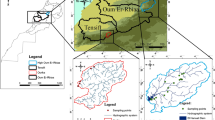Abstract
Measurements of the cosmogenically-produced 35S, a radioisotope of sulphur (t1/2 = 87 days), are reported for the Ned Wilson Lake watershed in Colorado. The watershed contains two small lakes and a flowing spring presumed to be representative of local ground water. The watershed is located in the Flattops Wilderness Area and the waters in the system have low alkalinity, making them sensitive to increases in acid and sulphate deposition. Time series of 35S measurements were made during the summers of 1995 and 1996 (July–September) at all three sites. The system is dominated by melting snow and an initial concentration of 16–20 mBq L-1 was estimated for snowmelt based on a series of snow samples collected in the Rocky Mountains. The two lakes had large initial 35S concentrations in July, indicating that a large fraction of the lake water and sulphate was introduced by meltwater from that year's snowpack. In 1995 and 1996, 35S concentrations decreased more rapidly than could be accounted for by decay, indicating that other processes were affecting 35S concentrations. The most likely explanation is that exchange with sediments or the biota was removing 35S from the lake and replacing it with older sulphate devoid of 35S. In September of 1995 and 1996, 35S concentrations increased, suggesting that atmospheric deposition is important in the sulphate flux of these lakes in late summer. Sulphur-35 concentrations in the spring water were highly variable but never higher than 3.6 mBq L-1 and averaged 2 mBq L-1. Using a simple mixing model, it was estimated that 75% of the spring water was derived from precipitation of previous years.
Similar content being viewed by others
References
Campbell, D. C., Turk, J. T. and Spahr, N. W.: 1991, 'Response of Ned Wilson Lake Watershed, Colorado, to changes in atmospheric deposition of sulfate', Water Resour. Res. 27, 2047–2060.
Cooper, L. W., Olsen, C. R., Solomon, D. K., Larsen, L. I., Cook, R. B. and Grebmeier, J. M.: 1991, 'Stable isotopes of oxygen and natural and fallout radionuclides used for tracing runoff during snowmelt in an Arctic watershed', Water Resour. Res. 27, 2171–2180.
Delleur, J. W.: 1989, 'Atmospheric Deposition', Proceedings of a Symposium of the Third Scientific Assembly of the International Association of Hydrologic Sciences, IAHS publication 179, Baltimore, Maryland, April 1989, 288 pp.
Krouse, H. R. and Mayer, B.: 2000, 'Sulphur and Oxygen Isotopes in Sulphate', P. Cook and A. L. Herczeg (eds), Environmental Tracers in Subsurface Hydrology, Kluwer Academic Publishers, The Netherlands, pp. 195–231.
Lal, D. and Peters, B.: 1966, Cosmic Ray Produced Radioactivity on the Earth, Handbuch der Physik, Springer-Verlag, New York, pp. 550–612.
Mast, M. A., Turk, J. T., Ingersoll, G. I. and Clow, D. W.: 2001, 'Use of stable sulfur isotopes to identify sources of sulfate in the Rocky Mountain snowpacks',Atmosph. Environ. (in press).
Michel, R. L. and Turk, J. T.: 1996, 'Use of 35S to Study Rates of Sulphur Migration in the Flat Tops Wilderness Area, Colorado', Proceedings of a Symposium on Isotopes in Water Resources Research, Vol. 1, Vienna, Austria, March 1995, pp. 293–301.
Michel, R. L., Campbell, D., Clow, D. and Turk, J. T.: 2000, 'Timescales for migration of atmospherically derived sulphate through an alpine/subalpine watershed, Loch Vale, Colorado, Water Resour. Res. 36, 27–36.
Spahr, N. E. and Turk, J. T.: 1985, Estimation of Evaporation from Ned Wilson Lake, Flattops Wilderness Area, Colorado, U.S. Geol. Surv. Water Resour. Invest. Rep 85-4244, 13 pp.
Sueker, J. K., Turk, J. T. and Michel, R. L.: 1999, 'Use of cosmogenic 35S for comparing ages of water from three alpine-subalpine basins in the Colorado Front Range', Geomorphology 27, 61–74.
Tanaka, K. and Turekian, K. K.: 1995, 'Determinations of the dry deposition of SO2 using cosmogenic 35S and 7Be measurements', J. Geophys. Res. 100, 2841–2848.
Turk, J. T. and Adams, D. B.: 1983, 'Sensitivity to acidification of lakes in the Flat Tops Wilderness Area, Colorado', Water Resour. Res. 19, 346–350.
Turk, J. T. and Spahr, N. E.: 1991, 'Rocky Mountains', in D. Charles (ed.), Acidic Deposition in Aquatic Ecosystems: Regional Case Studies, Springer-Verlag, New York, pp. 471–501.
Turk, J. T., Campbell, D. H., Ingersoll, G. P. and Clow, D. W.: 1992, Initial Findings of Synoptic Snowpack Sampling in the Colorado Rocky Mountains, U.S. Geological Survey Open-File Report 92-645, 6 pp.
Webb, J. H., Deviney, F. A., Cosby, B. J., Bulger, A. J. and Galloway, J. N.: 2000, 'Changes in the acid-base status of streams in Shenandoah National Park and the mountains of Virginia', Transactions of the American Geophysics Union 81, S258–S259.
Wieder, R. K., Novak, M. and Cerny, J.: 1998, Biogeochemical Investigations at the Watershed, Landscape, and the Regional Scales, Kluwer Academic Publishers, London, 505 pp.
Author information
Authors and Affiliations
Corresponding author
Rights and permissions
About this article
Cite this article
Michel, R.L., Turk, J.T., Campbell, D.H. et al. Use of Natural 35S to Trace Sulphate Cycling in Small Lakes, Flattops Wilderness Area, Colorado, U.S.A.. Water, Air, & Soil Pollution: Focus 2, 5–18 (2002). https://doi.org/10.1023/A:1020177802927
Issue Date:
DOI: https://doi.org/10.1023/A:1020177802927




